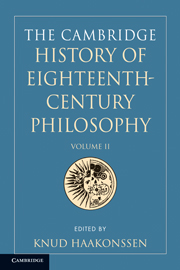30 - Natural Philosophy
from IV - Natural Philosophy
Published online by Cambridge University Press: 28 March 2008
Summary
NEWTON AND BEYOND
In the preface to his work on the metaphysical foundations of Newton’s science, Kant wrote that ‘since in any doctrine of nature there is only as much proper science as there is a priori knowledge therein, a doctrine of nature will contain only as much proper science as there is mathematics capable of application there’. Precisely because it is so radically uncompromising, Kant’s statement echoes much of the whole orientation of eighteenth-century natural philosophy. The Newtonian scheme of thought was proving a perfect instrument for research because something more fundamental and more general than Newton’s laws of motion had been discovered by means of mathematical exposition which was of greater universality than that employed by Newton himself. The successful outcome of such an ambitious enterprise was so significant that Kant went on to exclude chemistry from the realm of science proper on the grounds that, contrary to mathematical physics, the principles of chemistry ‘are merely empirical, and allow of no a priori presentation in intuition … they do not in the least make the principles of chemical appearances conceivable with respect to their possibility, for they are not receptive to the application of mathematics’ (Ak 4: 471). Kant seems not to have realised soon enough the significance of Lavoisier’s work in the 1770s, which practically founded chemistry on its present basis; after Lavoisier, chemical science had only to wait for the atomic theory in the next century. However in his later, post-critical work, Kant embarked on the ambitious project of including chemical phenomena in a wider metaphysical concept.
- Type
- Chapter
- Information
- The Cambridge History of Eighteenth-Century Philosophy , pp. 873 - 902Publisher: Cambridge University PressPrint publication year: 2000
References
- 1
- Cited by

